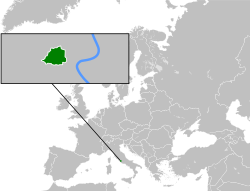Geography of Vatican

With an area of 0.17 sq mi (0.44 km2), it is the world's smallest independent state. Outside the Vatican City, thirteen buildings in Rome and Castel Gandolfo (the pope's summer residence) enjoy extraterritorial rights. (One building, the Paul VI Audience Hall, straddles the border, but its Italian portion has extraterritorial rights.) The country contains no major natural resources, and no known natural hazards other than those which affect Rome in general (such as earthquakes).
Vatican City has a total area of 108.7 acres (0.1698 sq mi; 0.440 km2). All of the almost 109-acre complex is land and no part of it is covered by water, though the Tiber River lies just outside of its borders to the east. It is a landlocked country that shares a 2-mile (3.2 km) international border with Italy. Most of the border is traditionally enforced with a stone wall, including the Leonine Wall on the western and southern sides.